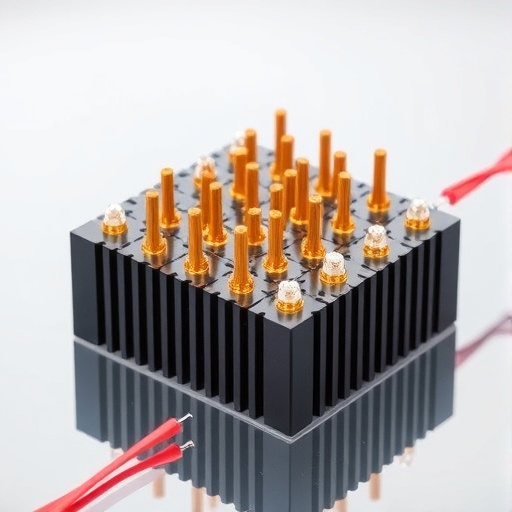In recent years, the race to enhance energy storage technologies has gained unprecedented momentum, driven largely by the ever-increasing demand for efficient, durable, and high-performance energy devices. In this context, hybrid capacitors have emerged as one of the most promising solutions. A groundbreaking study has unveiled a novel approach to improving the performance of asymmetric hybrid capacitors, highlighting the potential of utilizing a composite material that incorporates multi-walled carbon nanotubes (MWCNTs) in conjunction with CuMn2O4 and MnO2. Published in the esteemed journal Ionics, this research signifies a noteworthy advancement in the field of energy storage technologies.
The research foundationally explores the hydrothermal synthesis method, which is pivotal for fabricating the MWCNT-embedded CuMn2O4/MnO2 composite material. Hydrothermal synthesis is a well-established technique that allows for the formation of various nanostructures through chemical reactions in aqueous solutions at elevated temperatures and pressures. This method reduces the reliance on complex chemical processes while positioning the resultant material to exhibit enhanced electrochemical properties. The integration of MWCNTs plays a crucial role, enhancing the overall conductivity of the composite while simultaneously increasing its surface area—key attributes that contribute to high energy storage capacity.
In the quest for performance, the study dictates a meticulous examination of the electrochemical behavior of the developed composite. The results display that the composite system not only demonstrates improved charge-discharge characteristics but also superior cycle stability. This stability is vital in practical applications, as it suggests that devices utilizing this composite material could maintain performance over prolonged usage, addressing a common limitation seen in many conventional energy storage systems.
The unique combination of CuMn2O4 and MnO2 results in a synergy that optimizes the energy storage mechanisms of the composite material. CuMn2O4 contributes to the overall structural stability and offers promising electrochemical activity, while MnO2, renowned for its high pseudocapacitance, ensures that the composite exhibits the ideal characteristics for a high-performance positive electrode in hybrid capacitors. This dual-functionality presents an innovative approach to developing electrodes that can outperform traditional materials.
Moreover, the research team has meticulously characterized the morphology and crystal structure of the synthesized composite using various techniques. Scanning electron microscopy (SEM) and transmission electron microscopy (TEM) analyses reveal a well-distributed MWCNT network within the CuMn2O4/MnO2 matrix. This distribution is critical because the interconnected MWCNT structure enhances ionic and electronic transport pathways, facilitating more efficient electrochemical reactions during charge and discharge cycles. Visual representations from these analyses underscore the substantial progress in electrode design and optimization.
Furthermore, the electrochemical performance metrics gathered from cyclic voltammetry, galvanostatic charge-discharge tests, and electrochemical impedance spectroscopy elucidate the advantages of the MWCNT-embedded composite. The findings indicate not only a high specific capacitance but also remarkable energy density and power density values, placing this composite amongst the leading materials in the realm of hybrid capacitors. These performance indicators significantly surpass those of conventional materials, aligning with the research’s aspirations to push the envelope of current energy storage technologies.
The implications of this research extend beyond academic interest and technological innovation; they herald a new chapter in energy storage solutions tailored for modern-day demands. As applications ranging from electric vehicles to renewable energy integration become more prevalent, the need for devices capable of operating with high efficiency becomes paramount. The advancement in asymmetric hybrid capacitors, driven by this research, can potentially bridge the gap between energy supply and energy demand, ensuring enhanced performance in real-world applications.
In addition to direct energy applications, the findings may influence other sectors such as grid energy storage, consumer electronics, and even wearable technology, highlighting the versatility of the developed composite. The potential to scale up production and integrate these materials into real-world applications could revolutionize how we perceive and utilize energy storage systems.
With countries globally striving towards cleaner energy sources and reduced carbon footprints, the technology propelled by this research could play a crucial role in transitioning toward sustainable energy solutions. As industries accelerate towards electrification, advancements in hybrid capacitors become integral to realizing energy-efficient devices that meet the needs of a rapidly evolving market.
The collaboration among the researchers further accentuates the interdisciplinary nature of modern scientific inquiry. By merging expertise across several fields, the team achieved a level of innovation that single-discipline approaches may struggle to reach. This collaboration not only enhances the quality of research but also sets a precedent for future studies, illustrating the importance of shared knowledge in tackling complex scientific challenges.
In terms of future directions, the research opens avenues for investigating additional composite systems that could further refine the performance characteristics of asymmetric hybrid capacitors. This could entail experimenting with different conductive materials or varying the preparation protocols to optimize the synthesis process. Moreover, the environmental sustainability of the materials used, alongside the energy efficiency of the production methods, will be vital considerations as the research community continues to pave the way towards greener energy storage solutions.
Ultimately, the advance made through the hydrothermal synthesis of the MWCNT-embedded CuMn2O4/MnO2 composite not only marks a significant milestone in hybrid capacitor development but also provides a framework for ongoing exploration. The implications lie at the intersection of innovation, sustainability, and functionality, showcasing an essential stride towards achieving the high-performance energy systems required for future applications. The exciting journey ahead will undoubtedly attract further interest, promising enhancements that could revolutionize energy storage technologies for generations to come.
Subject of Research: Development of high-efficiency positive electrodes for hybrid capacitors using MWCNT-embedded CuMn2O4/MnO2 composites.
Article Title: Enhanced performance of asymmetric hybrid capacitors via hydrothermal synthesis of MWCNT-embedded CuMn2O4/MnO2 composite as a high-efficiency positive electrode.
Article References:
Parthiban, S., Kiruthiga, A., Karthikeyan, S.S. et al. Enhanced performance of asymmetric hybrid capacitors via hydrothermal synthesis of MWCNT-embedded CuMn2O4/MnO2 composite as a high-efficiency positive electrode. Ionics (2025). https://doi.org/10.1007/s11581-025-06743-x
Image Credits: AI Generated
DOI: https://doi.org/10.1007/s11581-025-06743-x
Keywords: Energy storage, hybrid capacitors, composite materials, hydrothermal synthesis, MWCNT, CuMn2O4, MnO2, electrochemical performance, sustainability.




